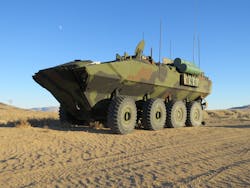BAE Systems to build 14 more Marine Corps ACV armored combat vehicles with advanced sensors and vetronics
QUANTICO, Va. – U.S. Marine Corps amphibious warfare experts are ordering 14 Amphibious Combat Vehicles (ACVs) and accompanying vetronics to replace the Corps's ageing fleet of amphibious assault vehicles (AAVs).
Officials of the Marine Corps Systems Command at Quantico Marine Base, Va., announced a $89.5 million order last week to the BAE Systems Platforms & Services segment in Sterling Heights, Mich., for 14 ACV armored combat vehicles. The total cumulative value of the contract is $1.8 billion.
The ACV is a wheeled armored combat vehicle able to move as many as 13 Marine infantry warfighters from ships offshore to fight their way onto invasion beaches. Marine Corps leaders cancelled the expensive expeditionary fighting vehicle (EFV) program in 2011.
The ACV's weapons and sensors enable the armored combat vehicle to destroy enemy helicopters, light armored vehicles, infantry, and unmanned aircraft, was well as to perform reconnaissance with active and passive night-vision, daylight cameras, radar, and infrared sensors.
The Marine Corps could end up purchasing as many as 204 vehicles over the next few years to outfit some of its 10 amphibious assault companies — the first phase of an incremental approach to replacing the AAV, which entered service in 1972.
The ACV is designed to accommodate new capabilities in the future as technology evolves, such as reconnaissance sensors, electronic warfare (EW) equipment, anti-air sensors and weapons, and integration with uncrewed aircraft.
In 2018 the Marine Corps chose BAE Systems as the ACV prime contractor over competitor Science Applications International Corporation (SAIC) in Reston, Va.
BAE Systems delivered the first vehicles in November 2019 to the 1st Marine Division. The first batch of 18 ACVs went to a platoon of the 1st Marine Division's 3rd Assault Amphibian Battalion earlier this fall at the Marine Corps Air Ground Combat Center in Twentynine Palms, Calif.
BAE Systems engineers are basing their ACV design on the Superav 8x8 amphibious armored personnel carrier developed by the Italian company Iveco Defence Vehicles.
ACV systems are designed to operate through enemy direct fire, indirect fire, and land mines with low-profile visual and infrared signatures, modular protection, and other armored vehicle technologies.
The vehicles can swim to shore from as far as 12 miles out to sea, switch from operating in the water to ground operations without pause, and then maneuver with M1 Abrams main battle tanks in a mechanized task force. The ACV can destroy relatively light enemy combat vehicles similar to itself.
The ACV will provide direct fire support for Marine infantry, and can carry 17 Marines at speeds of at least eight knots at sea amid three-foot waves with waves as large as three feet.
On shore, the ACV has high-ground clearance and a V-shaped hull to resist the effects of land mine blasts, and can operate with a wheel blown off.
Each ACV has a crew of three, an M2 .50 caliber machine gun in a remote weapons station, with the potential to install a stabilized dual-mount M2/Mark 19 grenade launcher turret.
On this order BAE Systems will do the work in York, Pa., Aiken, S.C.; San Jose, Calif.; Sterling Heights, Mich.; and Stafford, Va., and should be finished by July 2024. For more information contact BAE Systems Platforms & Services online at www.baesystems.com, or Marine Corps Systems Command at www.marcorsyscom.marines.mil.

